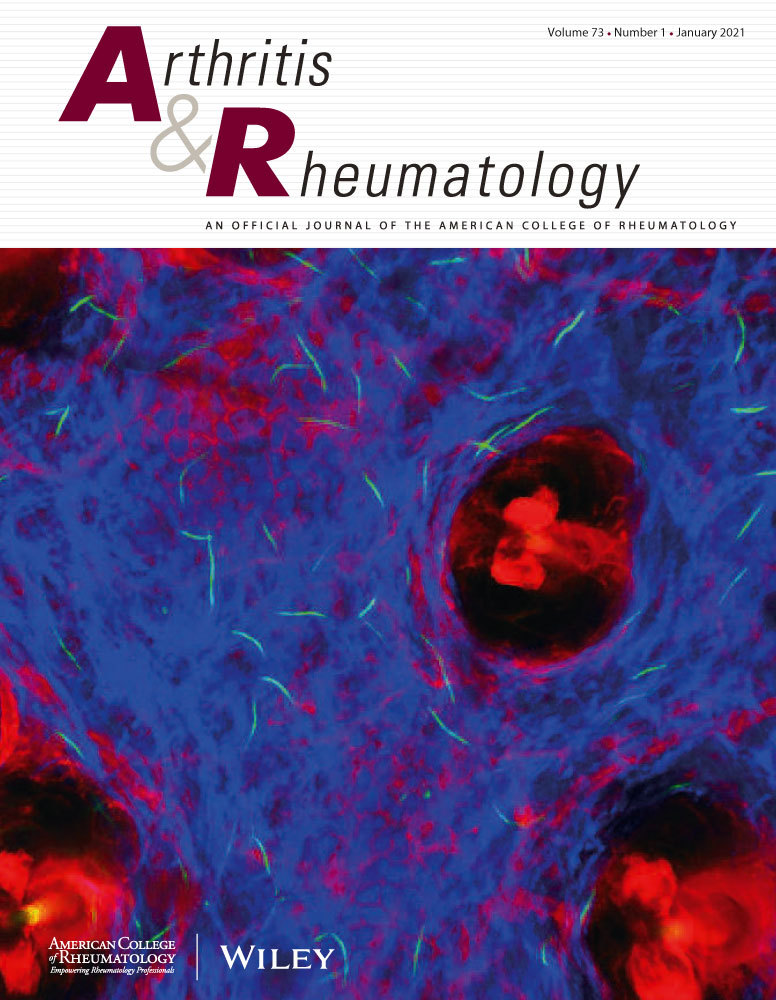缺乏软骨特异性Y-box结合蛋白1可抑制NF-κB信号传导并缓解骨关节炎的进展。
IF 10.9
1区 医学
Q1 RHEUMATOLOGY
引用次数: 0
摘要
目的探讨Y-box结合蛋白1 (YBX1)在骨关节炎(OA)发病机制中的作用。方法比较全膝关节置换术患者完整区和骨关节炎区软骨的蛋白质组学和磷酸化蛋白质组学,建立病理与YBX1上调的关系。正常C57BL/6和软骨特异性ybx1缺陷小鼠进行内侧半月板失稳手术;比较两组的行为、显微计算机断层扫描和组织学。YBX1在C28/I2细胞系中过表达,利用免疫沉淀和质谱技术鉴定了潜在的结合伙伴。MedChemExpress药物文库筛选潜在的YBX1小分子抑制剂,并将候选药物注射到小鼠OA模型关节内。结果骨关节炎组织中YBX1和YBX1在S102位点的总磷酸化水平高于正常软骨组织。在OA小鼠模型中,软骨细胞中Ybx1基因敲除可缓解疾病进展。软骨细胞中YBX1的上调激活了NF-κB信号。YBX1在S102位点的磷酸化促进其进入细胞核,抑制NF-κB抑制因子(NKRF),上调NF-κB靶基因。虚拟药物筛选发现橙皮苷、甲基查尔酮和桑葚苷A是抑制S102磷酸化、缓解损伤性OA小鼠模型疾病进展的候选药物。结论ybx1通过抑制NKRF,激活NF-κB信号通路参与OA进展;因此,靶向YBX1是治疗OA的潜在治疗策略。本文章由计算机程序翻译,如有差异,请以英文原文为准。
Deficiency of cartilage-specific Y-box binding protein 1 represses NF-κB signaling and alleviates osteoarthritis progression.
OBJECTIVE
To explore the role of Y-box binding protein 1 (YBX1) in the pathogenesis of osteoarthritis (OA).
METHODS
The proteome and phosphoproteome were compared between the intact and osteoarthritic regions of the cartilage from patients undergoing total knee arthroplasty, establishing a connection between the pathology and YBX1 upregulation. Normal C57BL/6 and cartilage-specific Ybx1-deficient mice underwent medial meniscal destabilization surgery; the behavior, micro-computed tomography, and histology were compared. YBX1 was overexpressed in the C28/I2 cell line, and potential binding partners were identified using immunoprecipitation and mass spectrometry. MedChemExpress drug libraries were screened for potential small-molecule inhibitors of YBX1, and candidates were injected intra-articularly into a mouse OA model.
RESULTS
The total YBX1 and YBX1 phosphorylated levels at S102 were higher in the osteoarthritic than intact human cartilage. Ybx1 knockout in chondrocytes alleviated disease progression in an OA mouse model. Upregulation of YBX1 in chondrocytes activated NF-κB signaling. Phosphorylation of YBX1 at S102 promoted its entry into the nucleus, where it inhibited NF-κB-repressing factor (NKRF), upregulating target genes of NF-κB. Virtual drug screening identified hesperidin methychalcone and mulberroside A as candidates for inhibiting S102 phosphorylation, alleviating disease progression in an injury-induced OA mouse model.
CONCLUSION
YBX1 contributes to OA progression by inhibiting NKRF, activating NF-κB signaling; therefore targeting YBX1 is a potential therapeutic strategy for the treatment of OA.
求助全文
通过发布文献求助,成功后即可免费获取论文全文。
去求助
来源期刊

Arthritis & Rheumatology
RHEUMATOLOGY-
CiteScore
20.90
自引率
3.00%
发文量
371
期刊介绍:
Arthritis & Rheumatology is the official journal of the American College of Rheumatology and focuses on the natural history, pathophysiology, treatment, and outcome of rheumatic diseases. It is a peer-reviewed publication that aims to provide the highest quality basic and clinical research in this field. The journal covers a wide range of investigative areas and also includes review articles, editorials, and educational material for researchers and clinicians. Being recognized as a leading research journal in rheumatology, Arthritis & Rheumatology serves the global community of rheumatology investigators and clinicians.
 求助内容:
求助内容: 应助结果提醒方式:
应助结果提醒方式:


